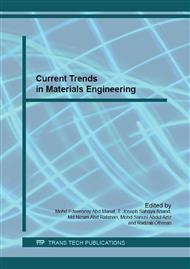[1]
X. Tang, K.A. Hu, Preparation and electromagnetic wave absorption properties of Fe-doped zinc oxide coated barium ferrite composites, Mater. Sci. Eng., B 139 (2007) 119-123.
DOI: 10.1016/j.mseb.2007.01.052
Google Scholar
[2]
H. H. Abdullah, A. Z. M. Asa'ari, N. I. M. Zawawi, L. C. Abdullah, S. Zakaria, Effects of physical treatments on the hydrophobicity of kenaf whole stem paper surface using stearic acid, BioResources, 8(3) (2013) 4088-4100.
DOI: 10.15376/biores.8.3.4088-4100
Google Scholar
[3]
J. Zhang, J. Li, Y. Han, Superhydrophobic PTFE surfaces by extension, Macromol. Rapid Commun. 25 (2004) 1105–1108.
DOI: 10.1002/marc.200400065
Google Scholar
[4]
L. Feng, Y. Song, J. Zhai, B. Liu, J. Xu, L. Jiang, D. Zhu, Creation of a superhydrophobic surface from an amphiphilic polymer, Angew. Chem. Int. Ed. 42 (2003) 800–802.
DOI: 10.1002/anie.200390212
Google Scholar
[5]
Z. Chen, F. Li, L. Hao, A. Chen, Y. Kong, One-step electrodeposition process to fabricate cathodic superhydrophobic surface, Appl. Surf. Sci. 258 (2011) 1395–1398.
DOI: 10.1016/j.apsusc.2011.09.086
Google Scholar
[6]
L. Feng, Z. Zhang, Z. Mai, Y. Ma, B. Liu, L. Jiang, D. Zhu, A superhydrophobic and super-oleophilic coating mesh film for the separation of oil and water, Angew. Chem. Int. Ed. 116 (2004) 2046–(2048).
DOI: 10.1002/ange.200353381
Google Scholar
[7]
N. Verplanck, Y. Coffinier, V. Thomy, R. Boukherroub, Wettability Switching Techniques on Superhydrophobic Surfaces, Nanoscale Res. Lett. 2 (2007) 577-596.
DOI: 10.1007/s11671-007-9102-4
Google Scholar
[8]
L. Cao, H. H. Hu, D. Gao, Design and fabrication of micro-textures for inducing a superhydrophobic behavior on hydrophilic materials, Langmuir 23 (2007) 4310-4314.
DOI: 10.1021/la063572r
Google Scholar
[9]
X. Zhang, X. Liu, J. Laakso, E. Levänen, T. Mäntylä, Easy-to-clean property and durability of superhydrophobic flaky c-alumina coating on stainless steel in field test at a paper machine, Appl. Surf. Sci. 258 (2012) 3102–3108.
DOI: 10.1016/j.apsusc.2011.11.045
Google Scholar
[10]
L. Feng, S. Li, H. Li, J. Zhai, Y. Song, L. Jiang, D. Zhu, Super-hydrophobic surface of aligned polyacrylonitrile nanofibers, Angew. Chem. Int. Ed. 41 (2002) 1221–1223.
DOI: 10.1002/1521-3773(20020402)41:7<1221::aid-anie1221>3.0.co;2-g
Google Scholar
[11]
H. Yang, Y. Deng, Preparation and physical properties of superhydrophobic papers, J. Colloid Interface Sci. 325 (2008) 588-593.
DOI: 10.1016/j.jcis.2008.06.034
Google Scholar
[12]
W. Wang, S. Ji, I. Lee, A facile method of nickel electroless deposition on various neutral hydrophobic polymer surfaces, Appl. Surf. Sci. 283 (2013) 309-320.
DOI: 10.1016/j.apsusc.2013.06.108
Google Scholar
[13]
S.S. Latthe, S.L. Dhere, C. Kappenstein, H. Imai, V. Ganesan, A.V. Rao, P.B. Wagh, S.C. Gupta, Sliding behavior of water drops on sol–gel derived hydrophobic silica films, Appl. Surf. Sci. 256 (2010) 3259–3264.
DOI: 10.1016/j.apsusc.2009.12.016
Google Scholar
[14]
A.V. Rao, S.S. Latthe, S.A. Mahadik, C. Kappenstein, Mechanically stable and corrosion resistant superhydrophobic sol–gel coatings on copper substrate, Appl. Surf. Sci. 257 (2011) 5772–5776.
DOI: 10.1016/j.apsusc.2011.01.099
Google Scholar
[15]
S.S. Latthe, H. Imai, V. Ganesan, A.V. Rao, Ultrahydrophobic silica films by sol–gel process, J. Porous Mater. 17 (2010) 565–571.
DOI: 10.1007/s10934-009-9325-0
Google Scholar
[16]
Z. Zheng, Z. Gu, R. Huo, Y. Ye, Superhydrophobicity of polyvinylidene fluoride membrane fabricated by chemical vapor deposition from solution, Appl. Surf. Sci. 255 (2009) 7263–7267.
DOI: 10.1016/j.apsusc.2009.03.084
Google Scholar
[17]
S. Wang, L. Feng, L. Jiang, One-step solution-immersion process for the fabrication of stable bionic superhydrophobic surfaces, Adv. Mater. 18 (2006) 767–770.
DOI: 10.1002/adma.200501794
Google Scholar
[18]
J. Shen, X. Qian, Use of mineral pigments in fabrication of superhydrophobically engineered cellulosic paper, Bioresources, 7 (2012) 4495-4498.
DOI: 10.15376/biores.7.4.4495-4498
Google Scholar
[19]
T.C. Chandra, M.M. Mirna, J. Sunarso, Y. Sudaryanto, S. Ismadji, Activated carbon from durian shell: Preparation and characterization, J. Taiwan Inst. Chem. Eng., 40 (2009) 457-462.
DOI: 10.1016/j.jtice.2008.10.002
Google Scholar
[20]
R. Farahiyan, M. K. Shahril, M. Abu, A. Y. B. Hashim, Green magnetic wave absorber: The potential of paddy straw and recycled paper, Mater. Res. Innovations 18 (2014) 21-25.
DOI: 10.1179/1432891714z.000000000926
Google Scholar
[21]
Z. Hu, X. Zen, J. Gong, Y. Deng, Water resistance improvement of paper by superhydrophobic modification with microsized CaCO3 and fatty acid coating, Colloids Surf., A. 351 (2009) 65-70.
DOI: 10.1016/j.colsurfa.2009.09.036
Google Scholar


